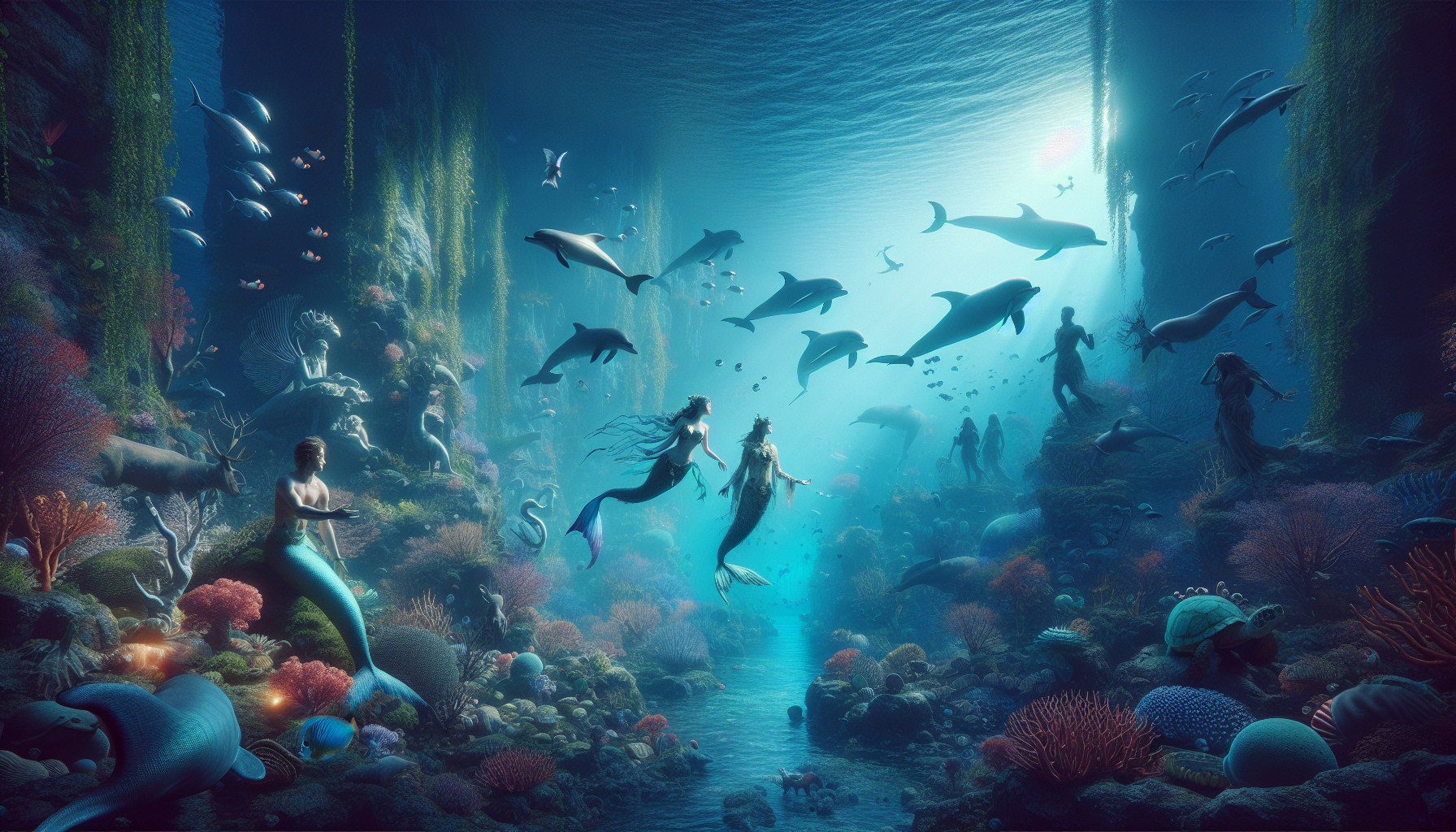In the vast, enigmatic depths of our planet’s oceans, a symphony of life reverberates—a concert conducted by nature itself. This intricate marine orchestra, known as biophony, is composed of the myriad sounds produced by living organisms. These acoustic signals, ranging from the haunting songs of whales to the rhythmic clicks of dolphins, create a complex soundscape that has captivated human imagination for centuries. But beyond scientific curiosity, these marine melodies have woven themselves into the very fabric of human culture, inspiring myths, legends, and folklore across diverse civilizations. 🌊
As we embark on a journey through the “Echoes of the Deep,” we will explore how the mysterious and mesmerizing sounds of the ocean have influenced storytelling traditions and mythologies around the globe. From the sirens of ancient Greek lore, whose alluring songs were said to lead sailors to their doom, to the legendary kraken of Norse mythology, whose monstrous presence was often heralded by ominous underwater roars, these narratives reveal the profound impact of marine acoustics on human perception and creativity. Through this exploration, we will not only uncover the stories themselves but also delve into the cultural contexts that gave rise to such rich and enduring folklore.
The tales of mermaids and sea monsters, though fantastical, reflect a deep-seated human fascination with the ocean’s hidden realms and its sonic inhabitants. By examining these stories, we gain insight into how different cultures have interpreted the mysterious sounds emanating from the deep. Are these myths merely fanciful tales, or do they serve a greater purpose—perhaps as allegorical warnings or reflections of humanity’s own fears and aspirations? Through our investigation, we will consider how ancient peoples, without the aid of modern technology, sought to understand and explain the auditory phenomena they encountered at sea. 🐋
The Enchanting World of Marine Biophony
The vast oceans of our planet are alive with sounds, both natural and mystical. Marine biophony refers to the soundscape of the sea, created by its inhabitants, ranging from the tiniest crustaceans to the largest whales. These sounds are not only vital for communication and survival among marine species, but they have also inspired countless folklore tales and myths throughout human history.
These deep-sea soundscapes provide insights into the complex interactions and communication methods of marine life. For instance, whales use haunting songs to communicate across vast ocean distances, while shrimps create snapping sounds that dominate the underwater soundscape in certain areas. By understanding marine biophony, we delve into a world that is as much auditory as it is visual, offering an immersive experience that extends beyond our conventional perception of the ocean.
Folklore and mythology have been deeply intertwined with marine biophony for centuries. The mysterious calls of whales have been interpreted as the songs of sea nymphs or sirens luring sailors to their doom. The snapping sounds of crustaceans have been mistaken for underwater fireworks or even battles between mythical sea creatures. These stories reveal how human culture has been influenced by the acoustic environment of the ocean, reflecting our fascination with the deep blue and its mysteries.
Marine Sounds in Folklore
Marine biophony has played a crucial role in shaping the folklore of coastal communities worldwide. The eerie calls of sea creatures, carried on the wind, have inspired tales of mythical beings and underwater kingdoms. For example, the legend of the Kraken, a giant sea monster said to dwell off the coasts of Norway and Greenland, may have been inspired by the strange and often terrifying sounds heard by sailors during long voyages. These myths served as explanations for natural phenomena and helped communities to make sense of the vast, unpredictable ocean.
Beyond tales of monsters, marine sounds have also been woven into the narratives of friendly and benevolent sea creatures. Dolphins, known for their playful behavior and complex vocalizations, are often depicted as helpers or guides to sailors. Their ability to “speak” has led to numerous legends about their wisdom and their role as intermediaries between humans and the ocean’s depths.
These stories, passed down through generations, illustrate how marine biophony has shaped cultural perceptions of the sea. By interpreting the sounds of the ocean, communities have crafted a rich tapestry of folklore that continues to captivate the imagination.
The Role of Mythology in Understanding Marine Sounds
Mythology provides a window into how ancient civilizations perceived and explained the natural world. Marine biophony, with its vast array of sounds, has undoubtedly contributed to the creation of various myths that persist today. These myths often incorporate elements of the ocean’s acoustic environment, offering explanations for the mysterious and unexplainable.
For instance, the Greek myth of the sirens, enchanting creatures who lured sailors to their deaths with their singing, reflects humanity’s struggle to understand the alluring and sometimes dangerous sounds of the sea. The sirens’ songs, said to be irresistible, are reminiscent of the mesmerizing songs of whales, which can travel great distances and captivate any listener.
Similarly, the mythology surrounding mermaids and their enchanting voices may have origins in the complex vocalizations of marine mammals. These stories highlight the human desire to anthropomorphize and attribute meaning to the natural sounds of the ocean, creating narratives that bridge the gap between the known and the unknown.
Interpreting Oceanic Legends
Legends and myths offer valuable insights into the cultural significance of marine sounds. They reveal how communities have historically interacted with the ocean and its inhabitants, reflecting the deep emotional connection between humans and the sea. By analyzing these narratives, we can gain a deeper understanding of how marine biophony has influenced cultural identity and worldview.
For example, Polynesian cultures have a rich oral tradition that includes stories of ocean voyages guided by the songs of marine life. These tales underscore the importance of listening to the ocean’s sounds as a means of navigation and survival. In this context, marine biophony is not just a backdrop but an integral part of cultural heritage and knowledge.
Understanding the mythological interpretations of marine sounds allows us to appreciate the enduring impact of these narratives. They offer a glimpse into the past, showing how our ancestors perceived and interacted with the world around them.
Modern Interpretations and Scientific Perspectives
In contemporary times, the study of marine biophony has gained scientific recognition, shedding light on the ecological roles of these sounds. Researchers have found that marine sounds are crucial for various biological processes, such as mating, territory establishment, and predator-prey interactions. This scientific exploration enhances our understanding of the ecological balance within marine ecosystems.
Advancements in acoustic technology have enabled scientists to record and analyze marine sounds in unprecedented detail. These studies have revealed the remarkable diversity and complexity of marine soundscapes, providing valuable data on the health of ocean habitats. For instance, changes in the intensity and frequency of marine sounds can indicate shifts in biodiversity or environmental stressors such as climate change and pollution.
Modern interpretations of marine biophony also highlight the importance of preserving these acoustic environments. Human activities, such as shipping and offshore drilling, introduce noise pollution that disrupts the natural soundscape, impacting marine life. Efforts to mitigate these impacts are essential for maintaining the ecological integrity of our oceans.
Scientific Discoveries in Marine Biophony
Research in marine biophony has uncovered fascinating insights into the lives of ocean creatures. For example, studies have shown that fish use sound for communication during spawning rituals, while certain species of crabs create unique sounds to attract mates. These discoveries underscore the complexity of marine ecosystems and the intricate relationships between sound and behavior.
Furthermore, scientific exploration of marine biophony has provided a deeper understanding of how sound influences the behavior of large marine mammals. The songs of humpback whales, for instance, have been found to follow distinct patterns and structures, suggesting a form of cultural transmission similar to human music.
The continued study of marine biophony promises to reveal even more about the fascinating world beneath the waves. By exploring the acoustic environment of the ocean, scientists are unraveling the mysteries of marine life, offering new perspectives on our planet’s most enigmatic ecosystems.
Interactive Exploration: Videos and More
To truly appreciate the depth and diversity of marine biophony, we invite you to engage with interactive resources that bring these sounds to life. Watching videos and listening to recordings can provide a more immersive understanding of the ocean’s acoustic environment.
One recommended video is “The Symphony of the Sea” by National Geographic. This video offers a stunning audio-visual journey into the world of marine sounds, capturing the essence of life beneath the waves.
Additionally, exploring the comparative table below can help you grasp the range of sounds produced by different marine species. This table highlights key characteristics and functions of marine biophony, offering insights into the diverse ways ocean creatures communicate.
| Species | Sound Type | Purpose |
|---|---|---|
| Humpback Whale | Song | Communication and mating |
| Dolphin | Clicks and whistles | Echolocation and social interaction |
| Shrimp | Snapping | Territorial defense |
Engaging with these resources not only enhances your understanding of marine biophony but also fosters a deeper appreciation for the intricate web of life in our oceans. As you explore these sounds and stories, consider the broader implications of preserving these vital acoustic environments for future generations.

Conclusion
Conclusion: Echoes of the Deep: Exploring Marine Biophony in Folklore and Mythology
In our exploration of marine biophony within folklore and mythology, we’ve navigated through a fascinating tapestry of human creativity and nature’s mysteries. This article delved into how the sounds of the sea have inspired narratives and beliefs across various cultures, each interpreting the enigmatic whispers of the ocean in unique ways. By examining these stories, we gain insight into the profound connection between humans and the marine world, a bond that has shaped cultural identities and spiritual beliefs for centuries.
The first key point discussed was the intrinsic link between marine biophony and mythology. Across cultures, the ocean’s sounds—ranging from the haunting calls of whales to the rhythmic crashing of waves—have served as a canvas for mythmakers. These auditory elements have been instrumental in creating narratives that explain natural phenomena, embody moral lessons, and reflect societal values. For instance, the Greek myths of sirens and mermaids capture the dual nature of the sea as both alluring and perilous, highlighting humanity’s respect and fear of the ocean’s vast power.
Secondly, we explored specific examples of folklore where marine biophony plays a central role. In Norse mythology, the sea’s roar was often attributed to the movements of the mighty Jörmungandr, the Midgard Serpent. In the Pacific Islands, the songs of the sea creatures are believed to carry the voices of ancestors, demonstrating a spiritual dimension to marine sounds that transcends generations. These stories not only entertain but also serve as cultural repositories, preserving the knowledge and traditions of peoples deeply connected to the ocean.
Another significant aspect of our discussion was the scientific basis of marine biophony and its influence on human perception. The study of bioacoustics has unveiled how marine creatures communicate through sound, painting a vibrant picture of underwater life. This scientific understanding has shed light on the origins of certain myths and enriched our appreciation of folklore as a form of proto-science. By interpreting the songs of the ocean, early cultures crafted narratives that reflect both their observations and imaginations, bridging the gap between myth and reality.
In considering the modern implications of these ancient stories, we acknowledged the role of marine biophony in contemporary conservation efforts. By understanding the cultural significance of ocean sounds, we can foster a deeper appreciation for marine environments and the need to protect them. The myths and folklore that have arisen from the sea’s symphony can inspire modern conservation narratives, highlighting the timeless connection between humans and the natural world.
As we conclude, it is essential to emphasize the importance of preserving both the marine environment and the cultural narratives it has inspired. The echoes of the deep are not just a source of myth and wonder, but a reminder of the fragile ecosystems that require our stewardship. By sharing these stories and their meanings, we can inspire others to value and protect our oceans, ensuring that the melodies of the sea continue to inspire generations to come.
We invite you to reflect on the stories and ideas presented in this article. How do these ancient tales resonate with you in today’s world? What role do you think folklore and mythology should play in modern conservation efforts? We encourage you to share your thoughts, engage in discussions, and spread the knowledge you’ve gained. Whether you choose to comment, share with friends, or apply these insights in your own life, your engagement can help keep the conversation about marine conservation and cultural heritage alive. 🌊📚
For further exploration of marine biophony and its cultural significance, we recommend visiting reputable sources such as the National Oceanic and Atmospheric Administration (NOAA), which provides insights into the acoustic environment of the ocean, and Smithsonian Ocean, offering rich resources on oceanic history and mythology. Let’s continue to explore, learn, and protect our world’s incredible underwater symphony.
Toni Santos is a sensory storyteller and soundscape artisan whose work explores the forgotten language of the Earth through acoustic ecology storytelling. With a deep reverence for the natural world’s sonic textures, Toni crafts narratives that awaken our ears to the subtle music of forests, winds, waters, and wild silence.
His creative journey is rooted in a desire to preserve and interpret the acoustic heritage of environments, both ancient and fragile. From the echo of birdsong in a disappearing jungle to the resonance of stones in sacred landscapes, Toni’s stories reflect the memory held in sound—often overlooked, yet deeply felt.
With a background in environmental aesthetics and sonic design, Toni blends field recordings, visual symbolism, and poetic insight to create immersive experiences that honor the sonic soul of nature. His work does more than document; it invites listeners to re-tune themselves to the rhythms of life that still pulse beneath modern noise.
As the voice behind Vizovex, Toni shares sound-based studies, ambient narratives, and reflective content that help others reconnect with how sound shapes memory, meaning, and place.
His work is a tribute to:
The lost soundscapes of vanishing ecosystems
The role of natural acoustics in cultural and emotional memory
The healing potential of listening deeply to the world
Whether you’re an artist, an ecologist, or someone drawn to the quiet power of listening, Toni invites you into a space where every rustle, ripple, and resonance becomes a story—one note, one place, one heartbeat at a time.





